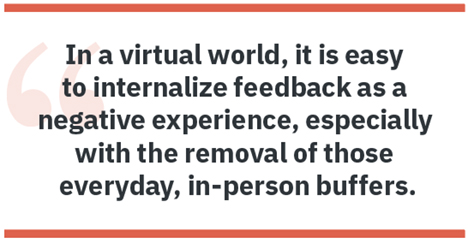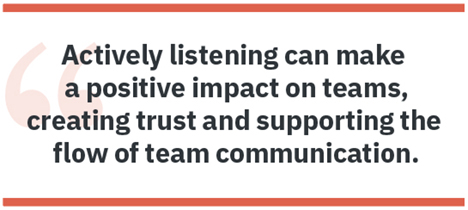By Siobhan Patterson | Gold Member
Communication is key for preventing burnout. Learn to recognize the signs of changes in team member behaviors and how to be intentional in your responses.
Through my career as a technical writer, I’ve found it invaluable to be intentional with communication style, time commitments, listening, and reading skills. This intention is often tested, particularly as irregular virtual chats replace casual cube chatter with more companies providing remote or hybrid work options. For these teams, the buffers of everyday run-ins have, to some extent, been eliminated, so sometimes workers only encounter what is sent in an email or chat message. Because of this, we need to be intentional in our interactions.
Set Time, Create Space, and Follow Up
We have to set time that aligns with others’ schedules and formally invite them for brief “coffee chats” or 1-on-1 catchups. It’s not as simple as catching someone in the breakroom or as they leave a conference room as it was in the office environment. We also need to be cognizant of how we use that scheduled time. If we’re training others to use software programs or adapt a new strategy program, we need to create space for those to ask questions and practice in real time. We also need to be intentional in offering virtual office hour blocks and follow-up sessions to help ensure that progress is moving in the right direction. We have to be intentional in our education plans and communication, acknowledging that one one-hour session won’t sustain the growth of the team’s knowledge and skills.
We also have to be intentional in how we communicate. In a virtual world, it is easy to internalize feedback as a negative experience, especially with the removal of those everyday, in-person buffers. Such feedback can even lead to friction and a lack of trust between team members when the only form of communication is a series of inquiries or a surplus of edits. In these moments, we need to pause and try to understand each other before reacting. Sometimes even scheduling a few minutes to talk in real time can help eliminate manufactured realities and potential burnout.
Recognize the Change
Often, there is this common notion to “embrace the change” and that even though change is painful, it may be necessary. Rather than embracing, we need to recognize the change in our colleagues. If we notice this change in either quality or attitude, we need to take a step back and recognize that there is a human behind the screen who is processing these changes—whether it’s a company merger or an organizational structure realignment. These types of changes could lead to layoffs or team redistributions, creating uncertainty and fear for those who are affected.
Some might ignore the issue and let the performance continue to suffer, but the key is to identify nonverbals and have an open conversation to pinpoint how to better support each other.

In a virtual world, it is easy to internalize feedback as a negative experience, especially with the removal of those everyday, in-person buffers.
I remember a scenario more than a decade ago as a leader for my undergrad’s campus publication. I spent three years with one of my editors and was familiar with the work she produced and her attention to detail. During one semester, there was a dip in her productivity and her designs were not up to her normal standards. I decided to check in with her and assess how things were going. It turned out she was dealing with some personal issues and stressed with her course load. The easy option could have been to mark up her work and tell her to redo the project, however taking those few minutes to check in and ask how she was doing, made a world of difference. As a result, we were able to resolve her workload issues and create a space for her to communicate future issues.
When we start to treat people as individuals instead of workers, we can create a safe space for them to communicate and work together to find solutions. It can help build a culture to make them feel valued and more than a line item in the budget. In doing so, it can also reduce project timelines. Assignments can be temporarily delegated to others without fear of being judged or losing their job. These delegations can then increase productivity and quality so that editors and project coordinators are not presented with incomplete or subpar drafts for review.
The New Virtual Reality
Despite changes in our work landscape, the decades-old in-office example is still applicable to today’s world. Even if we are not involved in daily communication like we would be in office, team cultures can adapt to the new virtual reality. It is important to pause and evaluate how the team is doing in these remote or hybrid environments.
For teams that require cameras for every meeting, this is the perfect opportunity to read the body language and facial expressions of team members when possible. We can assess team members’ engagement, whether they’re multitasking on a separate screen or if there’s a change in their demeanor that indicates discomfort in the current conversation.
Even with cameras off, we can take note of changes in inflection and participation. When there are team members becoming more vocal who do not usually speak up, this is an indication that they are experiencing change. There are various reasons for this, whether they want to pursue new responsibilities in their role, partake in leadership training, don’t agree with process changes, or are concerned with their future in the company.
These observations can be used to check in with individuals in a private setting, whether in a scheduled call or brief chat conversation. We can work with them to better understand their needs and encourage suggestions on how to improve their experience. This provides support to those who may not be confident communicating in a larger setting. By acknowledging patterns, we can increase our emotional intelligence and identify those who might need assistance.
For those private setting conversations, we can take advantage of this time to discuss individuals’ priorities. We can gain their perspective of team dynamics and workloads and help them identify goals and strategies. Through conversations with multiple team members, we can identify common themes, such as a need for specific training or advice for recurring issues, that could help the team as a whole. We can then use this insight and develop plans to address concerns or coordinate educational resources. It’s key that we use this feedback to evolve and act when possible. Actively listening can make a positive impact on teams, creating trust and supporting the flow of team communication. Change is difficult, but it’s worse to leave the team behind or make them feel as though their opinion doesn’t matter.
Actively listening can make a positive impact on teams, creating trust and supporting the flow of team communication.

Be Intentional
Ignorance isn’t bliss in a team environment. Ignoring or continuing to make excuses for known issues is the easy choice, but it’s not the healthy one. Sometimes, it’s easy for projects to fall toward the bottom of the priority list, because of expectations from other departments or leaders.
Cross-functional collaboration is an example of this. Each stakeholder has their own priorities and deadlines. When supporting a new product, writers work alongside product owners, marketing associates, user experience designers, and technical teams. Product owners need to run through a proof of concept, focus on development, and identify a beta client. Marketing has to choose the product name and involve the legal team before they start creating the necessary collateral. Technical teams must secure the environment and work with user experience designers to streamline the client journey. While these stakeholders are focused on their requirements, the user manual and associated bulletins are not likely at the top of their priority list. However, for writers, these projects are the focus and need to be included in conversation during product development in time for deployment.
As a result, writers must be intentional in their strategies and actively participate as part of the larger cross-functional team. If there are go-to-market activities with sprint meetings, it is important that we engage in those meetings. If there are demo sessions or practice runs in preparation for client meetings, it is important we are part of those discussions. We have to do everything in our power to be part of the conversation or we’ll get left behind and have to rush projects at the last minute. This lack of intention can also add unnecessary pressure and lower the quality of our projects. We need to take ownership of establishing those communication channels and conduct research to expand our understanding of the project. Initiating these relationships and showing interest in the process can help writers learn about the different personalities on the project team and how to best work alongside them.
For some projects, there are personalities committed to a collaborative environment. In many cases, they may appreciate your involvement and take the time to walk through the product features or user interface experience. They may also provide insight into how you can strategize documentation to match their expectations. If you can demonstrate a general understanding of processes and that you’ve completed some initial research, they might be more receptive to helping you learn the next level of technical information.
For other projects, there are those personalities that don’t have bandwidth, whether in time or personnel, to collaborate often. Their time may be limited, and they may be unable to provide additional product training calls or answer questions about feature functionality. By recognizing this type of personality, you can assess the communication method that would be more appropriate. In some instances, you might need to identify other resources in the organization who can support your documentation when the key stakeholders are unavailable. These resources could be other teams assigned to the project, such as client trainers or instructional designers.
Whichever type of project team you run across, keep a running log of project notes and touch base on a regular basis to review any relevant developments or delays that could affect your process. It’s on the writer to own the documentation process rather than to assume that key stakeholders will follow up once all their priorities are completed.
Ultimately, the writer is also responsible for communicating with their leaders and sharing any roadblocks hindering the process. In turn, the leader should monitor how the writer is handling the project—in terms of both quality and stress levels. When it’s smooth sailing, leaders can trust writers to continue the process as planned. However, if there are constant changes or delays in the product development preventing the writer to move forward, the leader must evaluate the situation. The leader and writer can work together to determine the best use of resources and rework the strategy to establish realistic goals. If we’re intentional in our communication, both with cross-functional teams and our leadership, we can help ensure our projects are given the time they deserve.
Save Your Teams
Communication is key to preventing burnout. By recognizing changes in behavior, both verbal and nonverbal, and choosing to be intentional in how you respond to these changes, you can improve your team’s culture. You own your experience as a writer, but you can also help others own their experiences by pausing and offering support, when needed, in the remote or hybrid environment.
 Siobhan Patterson builds messaging about technical topics for internal and external audiences at a telecommunications company. Previously, she was a technical writer in FinTech supporting new product development and a content producer in sports communication focused on developing build instructions and social media copy.
Siobhan Patterson builds messaging about technical topics for internal and external audiences at a telecommunications company. Previously, she was a technical writer in FinTech supporting new product development and a content producer in sports communication focused on developing build instructions and social media copy.
She earned a Master in Technical and Professional Communication from Auburn University and a Bachelor of Science in Communication Arts from the University of North Alabama.
In her spare time, she participates in her local bookstore’s reading challenge, attends barre fitness classes, and chauffers her family pup to all his social appointments.
She can be contacted at skgehrs@gmail.com.


